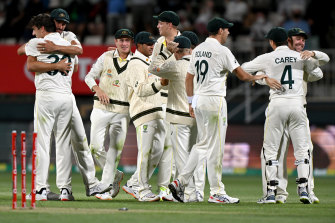Fast bowlers rule in England’s swift demise
The balance of power has shifted in the Ashes. Not the balance between Australia and England, which has tilted Australia’s way but always fluctuates, but the balance between bowlers and batsmen. On the last day of the rubber as on the first, Australia’s Hydra-like seam attack reduced England to abject and this time embarrassing capitulation.
Such was the Australian fast bowlers’ mastery that spinner Nathan Lyon did not bowl a ball for the match. But in a series whose meter was steep bounce, the unkindest cut of all for England captain Joe Root was to be bowled on Sunday evening by a Scott Boland grubber. He leaves still without a century in Australia after three tours.
Cameron Green celebrates after bowling Dawid Malan on day three on Sunday.Credit:Getty Images
For the second series in a row, in contradiction of the history of a game ruled and regulated by batsmen, bowlers have wielded the cat o’ nine tails. To be specific, that’s seam bowlers. No tickling opponents to death for them.
In England in 2019, it was Pat Cummins, Josh Hazlewood, Joffra Archer and Stuart Broad. Luckily for Australia, Jimmy Anderson was injured. The series is remembered for Steve Smith’s stupendous feats of batsmanship, but he was the exception that proved the rule.
This time, because of Australia’s injuries and England’s rotation policy, the spoils have been shared or rather divided among conquerors. But there have been plenty of them. Seam-friendly conditions can be expected in England, but not since the era of uncovered pitches has an Ashes series in Australia been played on five such playful pitches. It gave the series a martial aspect not seen since the summer of Mitch Johnson.
Two pink-ball Tests contributed. Every toss became one to lose. All summer long, the catches have flown into slips. Even good batsmen missed as much as they played. Every second shot was hurried.
These conditions should have narrowed the gap between the sides. Instead, it magnified them. Australia’s batsmen found a way, England’s didn’t. They finished the series cowering in a ditch.
The Australians enjoy the moment after winning the fifth Test at Blundstone Arena.Credit:Getty Images
Cameron Green has emerged as a fast bowler, a bonus for Australia since he is playing as a batsman. With him in the arsenal, Australia lays sieges as never-ending as Mafeking and Leningrad. It was he who tore on hole in England’s side under the floodlights on Sunday evening. The rest of the Australian attack rushed in like seater.
England had one thin consolation. Mark Wood came into his own. The fastest of the English bowlers, he was supposed to be used as a shock weapon, but in the end, he bowled more overs and took more wickets than any of his confreres and finished the series as the pick of their bowlers. He won the sort of admiration usually begrudged here.
On Sunday, Wood tyrannised Australia’s batsmen. Marnus Labuschagne was worried out of his wicket by Wood for the fourth time in five innings. He snookered Smith, widening a chink in previously impregnable method into fault line. At the end of the 2019 series, Smith’s Test average was 60. Since, it is 37.
Wood unsettled the rest of the order. Don’t listen to the bravado: no Test player like it. Outright pace is not everything – Boland and Ollie Robinson demonstrated that – but is inherent power of intimidation remains one of the primal forces in cricket. In the face of it, England disintegrated in the evening.
Mark WoodCredit:AP
One of the effects of this bowling insurrection has been to re-establish the value of hundreds. They’re fewer and more meaningful. Australia won this series so comprehensively because it dredged up five centuries to England’s miserable one. Extraordinarily, England did not once make 300 in the series. On Sunday evening, openers Rory Burns and Zak Crawly gave them their most promising start for the series – and then they lost 10-56.
More finely argued, fast bowling ascendancy has put a premium on all runs. Alex Carey was turned inside out while making 49 on Sunday afternoon, but as the day unfolded, those runs were worth their weight in bitcoin.
So an Ashes series was condensed into barely 19 playing days. One day surely, entitled batsmen will again break down this bowling hegemony, but in the end, care must be taken that the game does not become as narrow as it did when the West Indies prevailed.
The end of one Ashes series turns minds to the next. So consider this: In England in 2023, Australia should have at their disposal all the seamers from this match, plus Hazlewood, Jhye Richardson, Michael Neser and whoever else emerges from their bottomless well.
But England will have Wood and perhaps two bowlers even faster than him. The ill-starred Archer and Ollie Stone, as well as Robinson, and doubtlessly tailor-made conditions. Perhaps this new era of the fast bowler has a way to go yet. Bring it on – I think.
Most Viewed in Sport
From our partners
Source: Read Full Article



